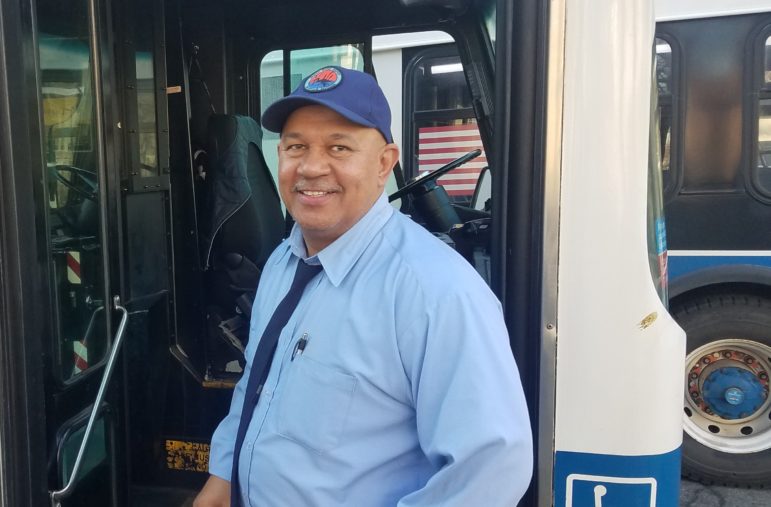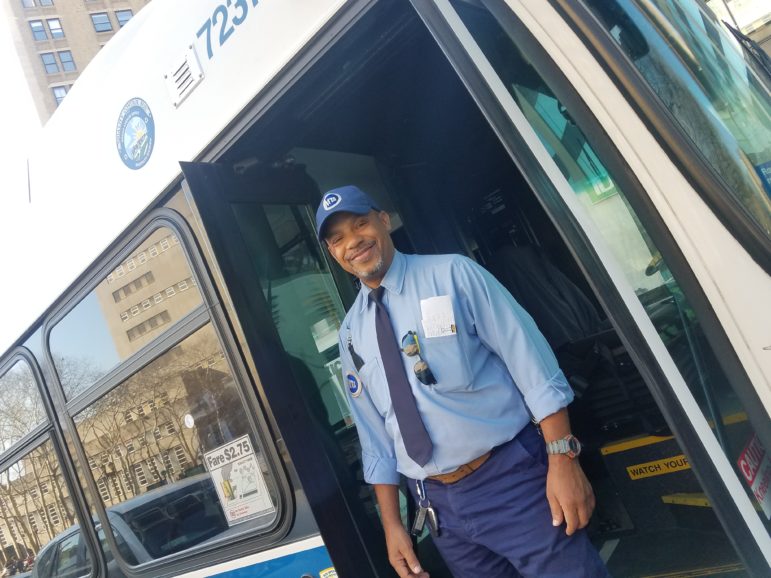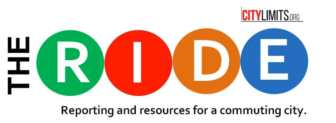
J. Murphy
Ralph Dejesus says crowding, altercations and 'people who think this is U-Haul' are not uncommon on the buses he drives in Brooklyn.
This story is part of a series about the city’s bus system.
* * * *
The anxiety of waiting at a New York City bus stop is rarely about whether or not the bus is coming. It’s about whether it will come in time. The position of bus advocates on the de Blasio administration’s “Bus Forward” strategy and the forthcoming MTA bus action plan is much the same.
The mayor’s plan, which was released in October, makes clear that the change advocates have wanted to see—more select bus service (SBS) routes along with technology and traffic enhancements to make those and other routes work better—is coming. The only problem is that they will arrive rather slowly.
Having launched the first one in 2008, the city currently has 15 SBS routes, which use designated lanes, make fewer stops, require passengers to pay before getting on the bus, and offer all-door boarding—features that the city Department of Transportation says have resulted in a 10 to 30 percent increase in speed and a 10 percent boost in ridership. SBS is the city’s form of “bus rapid transit,” or BRT.
The city’s Bus Forward strategy document identifies 21 candidate routes for new SBS service—including crosstown routes in Brooklyn and Manhattan, a path along the North Shore in Staten Island and service on Gun Hill Road in the Bronx or Union Turnpike in Queens. and calls for launching two to three new SBS routes per year over the next decade.
“I think it’s pretty good,” says Brooklyn Councilmember Brad Lander, who has pushed for more aggressive bus policy for years “It’s too slow. I feel like if that a five-year plan instead of a 10-year plan, I’d feel a lot better about it.”
“Two bus-rapid transit routes a year is basically what we were doing already,” Lander adds. “So I had hoped to see a more aggressive timetable in addition to just the next iteration of the plan — like, let’s not just keep going at the same pace, let’s double the pace.”
Bus Forward also commits the city and the MTA to applying some of the tools associated with SBS—like all-door boarding and off-board far collection—to regular bus lines lines. A plan for doing that is supposed to be prepared over the next several months and implementation will occur in 2018 and 2019, the report said. It identified 11 corridors, like Church Avenue in Brooklyn and Bay Street on Staten Island, for that work, although DOT warns that list could change.
Asked recently if there were any updates to the Bus Forward report—like which new SBS routes would be added first, or when they’d come on-line—the DOT declined to comment*. The de Blasio administration says it has increased the capital budget for SBS by $196 million to date. The MTA is according to some reports working on its own “bus action plan,” perhaps for release this spring.
Cooperation and controversy
Unlike the subway system, where direct city authority is lacking and there more public confrontation than cooperation between Albany and City Hall, there is a substantial local component to how the bus system is run. DOT is, for instance, in charge of deciding where bus lanes, stops and shelters go. What’s more, observers say, there is a more collaborative relationship between city and state on buses.
Nor is cost a major obstacle to improving buses. While adding bus routes and upgrading bus technology is not exactly cheap, it is way cheaper that any rail-based alternative. The proposed Brooklyn-Queens streetcar will cost $2.5 billion to build. The MTA’s current five-year capital plan for the entire bus system—all 5,800 buses over the 2,869 miles of the 317 routes—is $2.2 billion, and will cover the purchase of more than 1,700 buses and extensive work to repair or construct depots. It’s not an apples-to-apples comparison because individual buses carry fewer people over shorter distances at a slower pace than trains, but it is safe to say prohibitive cost is not the chief reason why the bus system has not been upgraded or expanded.
The biggest roadblock to expanding the SBS system—as well as to making SBS more like a true “bus rapid transit” system with hardened, bus-only lanes—is the possibility of local opposition. All urban space is contested, and the impact of SBS routes on driving and parking sometimes turns car owners and retail operators against proposals.
During the Bloomberg administration, furor over a proposed Hylan Boulevard SBS on Staten Island forced significant changes to it. Some Staten Island pols even got a state law passed to prevent SBS buses from using flashing blue lights. (The legislators argued that the lights confused drivers, who thought it meant an emergency vehicle was trying to get through—and, as you know, everyone moves out of the way for emergency vehicles in New York.)
A plan for a SBS route along 125th Street in Harlem ran into opposition from then-and-now Councilmember Bill Perkins and others in 2013 and was put on hold, though ultimately a route was created.
In 2016, civic associations in Woodhaven opposed an SBS there, with one activist claiming: “People are not going to come and shop. It’s going to be depressing for our community.”
What the drivers say

J. Murphy
Twenty-year bus veteran Osvaldo Ceri says he sees almost no enforcement of rules prohibiting private vehicles from spaces reserved for buses.
If expanding the bus system is controversial, fixing the current system is overdue. On a sunny afternoon in Brooklyn recently, three veteran bus drivers on break along Cadman Plaza talked about what the problems of the bus system look like from the driver’s seat.
Asked what was the primary cause for slow buses, Osvaldo Ceri, who has been driving for 20 years, said it was “the influx of outsiders coming into New York City, especially Brooklyn.”
“The influx is incredible. All these high-rises, all this construction and everything that comes with it. The speed has to be reduced for everybody because of the influx, as well. So it does take longer for us to get from point A to point B,” Ceri said. “We have a lot of buses going, but the influx of people is larger than the buses they can provide.”
This reflects an interesting dynamic, both on and off the buses, the city’s population is growing, and with it the traffic—other cars, bikes, pedestrians—with which buses have to compete. Bus ridership is decreasing overall, but a few lines are seeing major increases in riders: From 2015 to 2016, ridership on Staten Island’s S93 bus jumped by 13.9 percent. Brooklyn’s B32 and B70 buses saw spikes of 13 percent and 10.3 percent, respectively.
The spikes in ridership, at least at key times, have made the insides of buses more tense. “Like in the mornings, forgettabout it,” said Ralph de Jesus, who has driven for 13 years. “It’s crowded. A lot of traffic.” Sometimes arguments break out. “Right now, this week, I had three altercations. You know ‘Move out of my way,’ ‘Move back,’ ‘Let the driver do his job.'” He doesn’t usually intervene. But he does put a stop to people trying to bring big items onto crowded buses. “You know, you got the people who think this is U-Haul. They want to come in with their furniture. They want to come in with their cans. You name it, they want to come in here. We’ve got to put a stop to it, you know, because of the safety issues for our people.”
Simon Taveras, 16-year veteran, said he often has to bypass stops because his bus is simply too crowded to take on additional passengers. “Rush hour. It happens pretty often. If there’s a bus missing, then you’re going to get a big crowd,” he said. Asked about the most frustrating aspect of the job, Taveras ticked off several answers. “I guess people who don’t pay. They just walk on the bus. They try to sneak on the back,” he said, then added: “The guys on the bikes and the cabs dipping and cutting in front of you. And the people with the headphones and the phones walking across the street. They won’t look. You come pretty close to hitting one of these guys. That’s really frustrating. That really gets to you.”
We asked what the drivers thought would help make the system work faster, Taveras said more spacing between buses would help, Ceri said more buses are needed and Dejesus said more bus lanes are essential.
Two of the drivers noted a lack of bus-lane enforcement in the city. “You know how it is. Some cars are always going to block the bus lane or bus stop. They’re never going to stop,” Ceri said. “Personally, I have never seen a police officer actually stop anybody or pull anybody over because of that. I’ve never seen it.”
“They need to put [cops] like on Flatbush and Fulton. Especially at rush hour, like now. They need to put people out there,” Dejesus said. “Because, you know, people, they don’t go by the rules. They don’t follow the lights. They try to beat that light. Then they get caught in the middle so we’ve got to stay back. Because if we get caught in the middle, you know what happens.”**
Bus Lane Enforcement
(Source)
| Calendar Year | Bus Lane Summonses | Total Motor Vehicle summonses | Share of MV summonses for bus-lane violations |
| CY2012 | 7,756 | 1,020,754 | 0.76% |
| CY2013 | 5,472 | 1,036,942 | 0.53% |
| CY2014 | 2,745 | 1,062,504 | 0.26% |
| CY2015 | 2,892 | 1,003,043 | 0.29% |
| CY2016 | 1,948 | 1,042,703 | 0.19% |
| CY2017 | 2,020 | 1,059,256 | 0.19% |
A different population
At a City Council hearing last week, MTA chairman Joe Lhota received just two questions about buses over 90 minutes of testimony. Discussion of the transit crisis remains focused on subways, which carry nearly three times as many people as buses every day, and also serve a more affluent, younger, whiter and better educated constituency.
“For a range of reasons the visibility of the subway crisis and the social privilege of subway riders relative to bus riders means that the subway crisis gets dramatically more attention than the bus crisis,” Lander says. While he gives credit to advocates for getting the buses what little visibility they have achieved over the past few months, Lander believes, “We aren’t talking about the bus crisis nearly enough.”
The demographics and size of their respective riderships aren’t the only difference between subways and buses, of course. Ridership trends also separate the two modes. Subways have seen soaring rider numbers. But bus ridership, according to the Transit Center, has slipped by 16 percent since 2002. This creates the potential for a downward spiral: When bus ridership slips, and farebox revenue drops, it can be seen as a signal that service ought to be reduced or at least that improvements are not justified. The resulting poor service means ridership slips more, restarting the vicious cycle.
The city and MTA both say they are committed to avoiding that kind of dynamic. In answer to those bus questions at last week’s Council hearing, Lhota said the MTA’s coming bus plan will look at rejiggering bus routes to reflect demographic changes and at how to better deal with congestion. Unlike the subway system, the bus system does not have an infrastructure problem, the chairman said, since most buses are fairly modern.
That diagnosis overlaps with what bus advocates have said. The TransitCenters “Bus Turnaround” campaign highlights the need to redesign bus routes to be more efficient—less circuitous and shorter, with better thinking about where to site bus stops—and helping buses navigate traffic better with tighter scheduling and more communication between drivers and dispatch.
But TransitCenter also calls for new attention to bus infrastructure, like redesigning buses to accommodate more riders, and retooling streets to accommodate more and faster buses. Redesigning streets means installing islands for boarding buses and creating dedicated bus lanes; in other words, reapportioning precious street-space from primarily serving private vehicles to prioritizing buses—precisely the kind of move that has triggered political resistance in the past, and which will require real leadership to navigate now. Elected officials might have to stand up to local resistance if a better citywide bus system is to emerge.
“There’s no doubt that localized opposition is a real challenge here,” Lander says. “It isn’t fair of the Council to say as a collective body we want a much more comprehensive and rapid implementation of bus rapid transit and bus improvements but then essentially back local members in any instance where the community resists it.”
“Of course, that’s the kind of tension that exists in trying to have a city. We need comprehensive infrastructure and it’s harder to get that. There’s often localized resistance to local forms of change. So that’s a real problem.”
* Clarification: After publication, DOT noted that the B82 SBS route for southern Brooklyn is expected to begin operating this year. The city also plans to double the number of intersections where Transit Signal Priority is available from 500 to 1000 by 2020.
** DOT also noted that in addition to NYPD-issued moving violations, the city also uses bus-lane cameras along 12 miles of bus route. Those cameras recorded 134,000 violations last year, up from 119,000 in 2015.









3 thoughts on “Will Fixes for the NYC Bus System Arrive Faster Than NYC Buses Do?”
Pingback: Today’s Headlines – Streetsblog New York City
Excellent piece. No quibbles.
Pingback: Today's Links: Road Crew Waves Red Flag, A History of Brooklyn's Women's Suffrage & More - BKLYNER